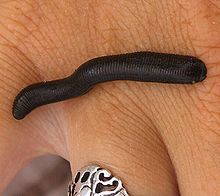Leech treatment
In leech treatment , leeches (usually Hirudo officinalis or Hirudo medicinalis ) are placed in a suitable place so that they induce a small bloodletting of around eight to ten milliliters of blood . Through the in the saliva (Saliva) of the leeches u. a. The anticoagulant substances contained in it ( hirudin and others) result in bleeding, which in rare cases can last up to 24 hours.
In evidence-based medicine , leech therapy is used almost exclusively in the field of plastic surgery today . Leeches are used primarily for transplants of ears, fingers, toes or skin transplants in order to improve wound healing with the help of the active ingredients in leech saliva. Due to the anticoagulant and vasodilating or anticonvulsant effect of hirudin, the venous outflow of congested blood can be stimulated or even made possible in the first place, so that the reimplants are not rejected or die.
Historical background
Leech therapy is one of the oldest healing methods in medical history. The first traditions of leech therapy come from Mesopotamia (3,300 BC). However, the first clear descriptions of leech therapy come from Indian medicine. The mythical figure Dhavantari, the doctor who revealed traditional Indian medicine to the world, carried nectar in one hand and a leech in the other. The most extensive description of this therapy can be found in Sushruta (100–600 BC). The traditional Chinese medicine (TCM) used leech therapy, but they played there ever a more subordinate role. In Europe, leech therapy was an indispensable part of medical therapy from ancient times (Nicandros von Kolophon 200–130 BC; Galen 129–199 AD) until the 19th century, but it was also always part of folk medicine.
effect
According to naturopathy , the effect of leech treatment is based on several factors: the stimulus to bite, the substances contained in the leech's saliva that are released by the bite, the leech's bacterial flora and the bleeding that takes place.
There are hardly any scientific studies on effectiveness to date. A study on the effectiveness of leech treatment for knee osteoarthritis can be found on the website of the Karl and Veronica Carstens Foundation . This allows the conclusion that the leech therapy has an effect on arthrosis of the joints. However, the authors point out the lack of informative value of this study, among other things because of the lack of a control group, accompanying treatment during the study and the short study duration of seven days. In another small study as part of a doctoral thesis (2009) “leech therapy appears as a possible expanded option for the symptomatic therapy of advanced rhizarthrosis ”. However, here, too, the discussion points out that the study is not conclusive. Among other things, with references to the placebo effect, the choice of control therapy and a lack of evaluation of a long-term effect. The IGeL monitor of the MDS (Medical Service of the Central Association of Health Insurance Funds) also speaks of inadequate data on leech therapy for knee osteoarthritis . After a systematic research of the scientific literature, he rates this self-pay service as “tending to be negative”. The placebo effect is likely, there is no evidence of a benefit, but evidence of minor damage (skin irritation with itching and rare bleeding).
Side effects and risks
There may be bruises around the bite site, which will subside after a few days. As a rule, there is a slight swelling of the areas, often associated with severe itching . Wound infection can be triggered by scratching . After treatment, blood pressure may drop and circulatory weakness may occur. The bite sites usually heal within a few weeks, but in rare cases small scars remain.
Since the blood absorbed by the leeches remains liquid in the animal's body for a long time and is only broken down slowly by peptidases , the leech can harbor many pathogens. Protozoa ( toxoplasmosis , trypanosomes , plasmodia ) and bacteria ( streptococci , clostridia , aeromonas ) were detected. A transmission of HIV could also be proven experimentally . In practice, however, it is still a matter of dispute to what extent a transmission can actually take place. In order to avoid the risk of patient-to-patient transmission, the leeches should be grown under controlled conditions and each leech should only be used once for treatment. After the medical use, the leeches are either killed or housed in so-called pensioner ponds .
See also
Individual evidence
- ↑ Dieter Melchart and a .: naturopathic treatment. Schattauer, 2002, ISBN 3-7945-2615-5 .
- ↑ Andreas Michalsen, Manfred Roth: Leech therapy. 3. Edition. Karl F. Haug Verlag, Stuttgart 2012, ISBN 978-3-8304-7527-9 .
- ↑ Paul van Dijk: Volksgeneeskunst in Nederland en Vlaanderen (The folksgeneeskundige recepten zijn mede made by Hanneke Winterwerp). (1981) 2nd ed. Deventer 1982, p. 55.
- ↑ Leech Therapy. on the website of the Carstens Foundation
- ↑ Özgür Cesur: Randomized controlled study on the effectiveness of leech therapy in symptomatic rhizarthrosis. (PDF; 560 kB) University of Duisburg-Essen, 2009.
- ↑ Evaluation of leech therapy for knee osteoarthritis . IGeL monitor; accessed on November 9, 2018. More details on the studies in Evidence Synthesis (PDF)
- ↑ Non-drug and alternative therapies: leeches. aok.de

